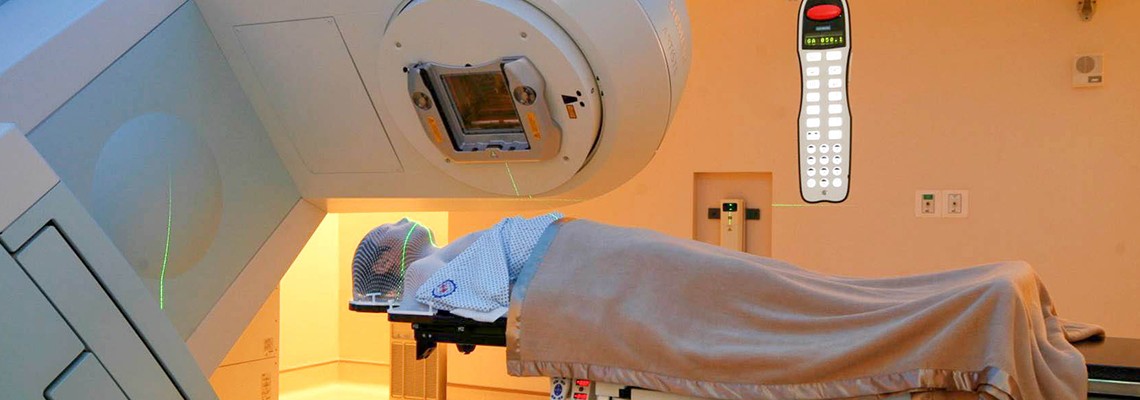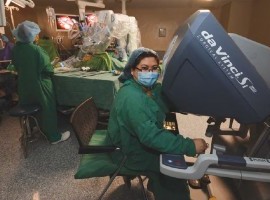
Department of Radiation Oncology
The Department of Radiation Oncology of St. Luke's Medical Center features highly-trained cancer specialists, medical physicists, specialty nurses, seasoned radiology technicians and state-of-the-art medical technology. As St. Luke's is a training hospital, residents-in-training are also present in the department to assist our experts in daily clinics and patient care. Our subspecialized medical experts participate in the hospital's frequent multidisciplinary conferences, have internationally published papers, and work together with other cancer experts locally and abroad such as Medical Oncologists, Surgeons, Hematologists and others to ensure comprehensive and updated cancer care. The other members of the department are the front-liners in Radiation Safety and all these combined allow the department to provide world class cancer treatments in the Philippines for the variety of cancer patients it caters to daily.
Open daily from Monday to Friday, the department is able to provide out-patient cancer treatment to as many as 70-100 patients everyday. Patients with brain tumors, head and neck tumors, lung cancer, breast cancer, gastrointestinal cancers, bladder cancer, prostate cancer, hematological cancers, and even some benign tumors are managed using the departments 2 linear accelerators while gynecologic tumors are managed using a high dose brachytherapy machine.
Procedures for Radiation Oncology
The department's machines are currently able to perform the following:
Procedure |
What is it? |
Typically used for what diagnoses? |
|
Conventional Radiation Therapy |
A radiation technique that has been around for many years, conventional radiation therapy directs radiation beams to the tumor and uses lead blocks to minimize dose to nearby healthy tissue. |
All cancers/sites |
|
3D Conformal Radiation Therapy (3DCRT) |
A procedure that uses computers to create a 3-dimensional picture of the tumor in order to target the tumor as accurately as possible while allowing the nearby healthy tissue to absorb even less radiation compared to the conventional radiotherapy technique. |
Lung cancer Breast cancer Rectal cancer Prostate cancer |
|
Intensity Modulated Radiation Therapy (IMRT) |
IMRT is a state-of-the-art radiation delivery system that is used to treat difficult-to-reach tumors, tumors very close to normal organs and patients who need re-irradiation. The intensity of the radiaiton beams can be adjusted to ensure that maximum dose is directed to the tumor. |
Head and neck cancers Esophageal cancer Gastric cancer Bladder cancer Anal cancer |
|
Stereotactic Radiosurgery (SRS) |
SRS is a non surgical radiation therapy technique used to treat small tumors of the brain and functional abnormalities. It can deliver precisely-targeted radiation in few dose treatments and can help preserve healthy tissue. |
Arterovenous malformations Brain metastases Pituitary tumors Meningioma Acoustic Schwannoma Base of the skull tumors |
|
Stereotactic Body Radiotherapy (SBRT) |
When SRS is used to treat body tumors, it is called SBRT. |
Early stage lung cancer Spine metastases Hepatocellular carcinoma Liver metastases |
|
Fractionated Stereotactic Radiotherapy (FSRT) |
FSRT is when SRS is given in more fractions than 1 as for generally larger tumors or tumors in close proximity to important normal structures such as the spinal cord and the brainstem. |
Tumors near the spinal cord Tumors near the brainstem |
|
High Dose Rate Brachytherapy (HDR Brachytherapy) |
HDR brachytherapy is a type of internal radiation therapy that delivers radiation from implants placed closed to, or inside the body. |
Cervical cancer Endometrial cancer Prostate cancer |
|
Image Guided Radiation Therapy (IGRT) |
IGRT is the use of imaging during radiation therapy to improve the prcision and accuracy of treatment delivery. It is commonly used give high radiation doses to tumors of the prostate gland to ensure rectal and bladder sparing. |
Prostate cancer Esophageal cancer Gastric cancer |
|
Image Guided Brachytherapy (IGBT) |
IGBT is the use of advanced imaging techniques to make brachytherapy more accurate, safe, and effective. |
Cervical cancer Endometrial cancer |
|
Total Body Irradiation (TBI) |
Total body irradiation is a form of radiotherapy used primarily as part of the preparative regimen for haematopoietic stem cell transplantation |
Leukemia Patients who will undergo bone marrow transplantation |
|
Respiratory Gating |
This is an important feature of St. Luke's' linear accelerator that allows tumors in areas of the body that move such as the upper abdominal area and the lower lung area to be treated accurately despite being non-stationary. |
Upper abdominal tumors lower lung tumors |
|
Procedure |
Conventional Radiation Therapy |
|
What is it? |
A radiation technique that has been around for many years, conventional radiation therapy directs radiation beams to the tumor and uses lead blocks to minimize dose to nearby healthy tissue. |
|
Typically used for what diagnoses? |
All cancers/sites |
|
Procedure |
3D Conformal Radiation Therapy (3DCRT) |
|
What is it? |
A procedure that uses computers to create a 3-dimensional picture of the tumor in order to target the tumor as accurately as possible while allowing the nearby healthy tissue to absorb even less radiation compared to the conventional radiotherapy technique. |
|
Typically used for what diagnoses? |
Lung cancer Breast cancer Rectal cancer Prostate cancer |
|
Procedure |
Intensity Modulated Radiation Therapy (IMRT) |
|
What is it? |
IMRT is a state-of-the-art radiation delivery system that is used to treat difficult-to-reach tumors, tumors very close to normal organs and patients who need re-irradiation. The intensity of the radiaiton beams can be adjusted to ensure that maximum dose is directed to the tumor. |
|
Typically used for what diagnoses? |
Head and neck cancers Esophageal cancer Gastric cancer Bladder cancer Anal cancer |
|
Procedure |
Stereotactic Radiosurgery (SRS) |
|
What is it? |
SRS is a non surgical radiation therapy technique used to treat small tumors of the brain and functional abnormalities. It can deliver precisely-targeted radiation in few dose treatments and can help preserve healthy tissue. |
|
Typically used for what diagnoses? |
Arterovenous malformations Brain metastases Pituitary tumors Meningioma Acoustic Schwannoma Base of the skull tumors |
|
Procedure |
Stereotactic Body Radiotherapy (SBRT) |
|
What is it? |
When SRS is used to treat body tumors, it is called SBRT. |
|
Typically used for what diagnoses? |
Early stage lung cancer Spine metastases Hepatocellular carcinoma Liver metastases |
|
Procedure |
Fractionated Stereotactic Radiotherapy (FSRT) |
|
What is it? |
FSRT is when SRS is given in more fractions than 1 as for generally larger tumors or tumors in close proximity to important normal structures such as the spinal cord and the brainstem. |
|
Typically used for what diagnoses? |
Tumors near the spinal cord Tumors near the brainstem |
|
Procedure |
High Dose Rate Brachytherapy (HDR Brachytherapy) |
|
What is it? |
HDR brachytherapy is a type of internal radiation therapy that delivers radiation from implants placed closed to, or inside the body. |
|
Typically used for what diagnoses? |
Cervical cancer Endometrial cancer Prostate cancer |
|
Procedure |
Image Guided Radiation Therapy (IGRT) |
|
What is it? |
IGRT is the use of imaging during radiation therapy to improve the prcision and accuracy of treatment delivery. It is commonly used give high radiation doses to tumors of the prostate gland to ensure rectal and bladder sparing. |
|
Typically used for what diagnoses? |
Prostate cancer Esophageal cancer Gastric cancer |
|
Procedure |
Image Guided Brachytherapy (IGBT) |
|
What is it? |
IGBT is the use of advanced imaging techniques to make brachytherapy more accurate, safe, and effective. |
|
Typically used for what diagnoses? |
Cervical cancer Endometrial cancer |
|
Procedure |
Total Body Irradiation (TBI) |
|
What is it? |
Total body irradiation is a form of radiotherapy used primarily as part of the preparative regimen for haematopoietic stem cell transplantation |
|
Typically used for what diagnoses? |
Leukemia Patients who will undergo bone marrow transplantation |
|
Procedure |
Respiratory Gating |
|
What is it? |
This is an important feature of St. Luke's' linear accelerator that allows tumors in areas of the body that move such as the upper abdominal area and the lower lung area to be treated accurately despite being non-stationary. |
|
Typically used for what diagnoses? |
Upper abdominal tumors lower lung tumors |
As you spend a few minutes each day in the Radiation Oncology Department of St. Luke's, you get to interact with the accomodating staff members and the other patients of the department; thereby allowing each and everyday to be a cozy and inviting atmosphere. Providing excellent medical and personal care for both in-patient and out-patient cancer treatment certainly makes the department a cut above the rest.
For appointments and queries, you may contact 723-0101 local 5414 (St. Luke's Medical Center, Quezon City) or 789-7700 local 1010 (St. Luke's Medical Center, Global City).
Department of Radiation Oncology
CONTACT INFO
Ground Floor, Department of Radiation Oncology, Main Building
Rizal Drive cor. 32nd St. and 5th Ave
Taguig City, Philippines
279 E Rodriguez Sr. Ave,
Quezon City, Philippines

